Interview with Artist Mirra Kan by Anérea
Posted on 4 January 2024; updated on 6 January 2024
This article is part of the newsletter column Tolkien Fanartics.
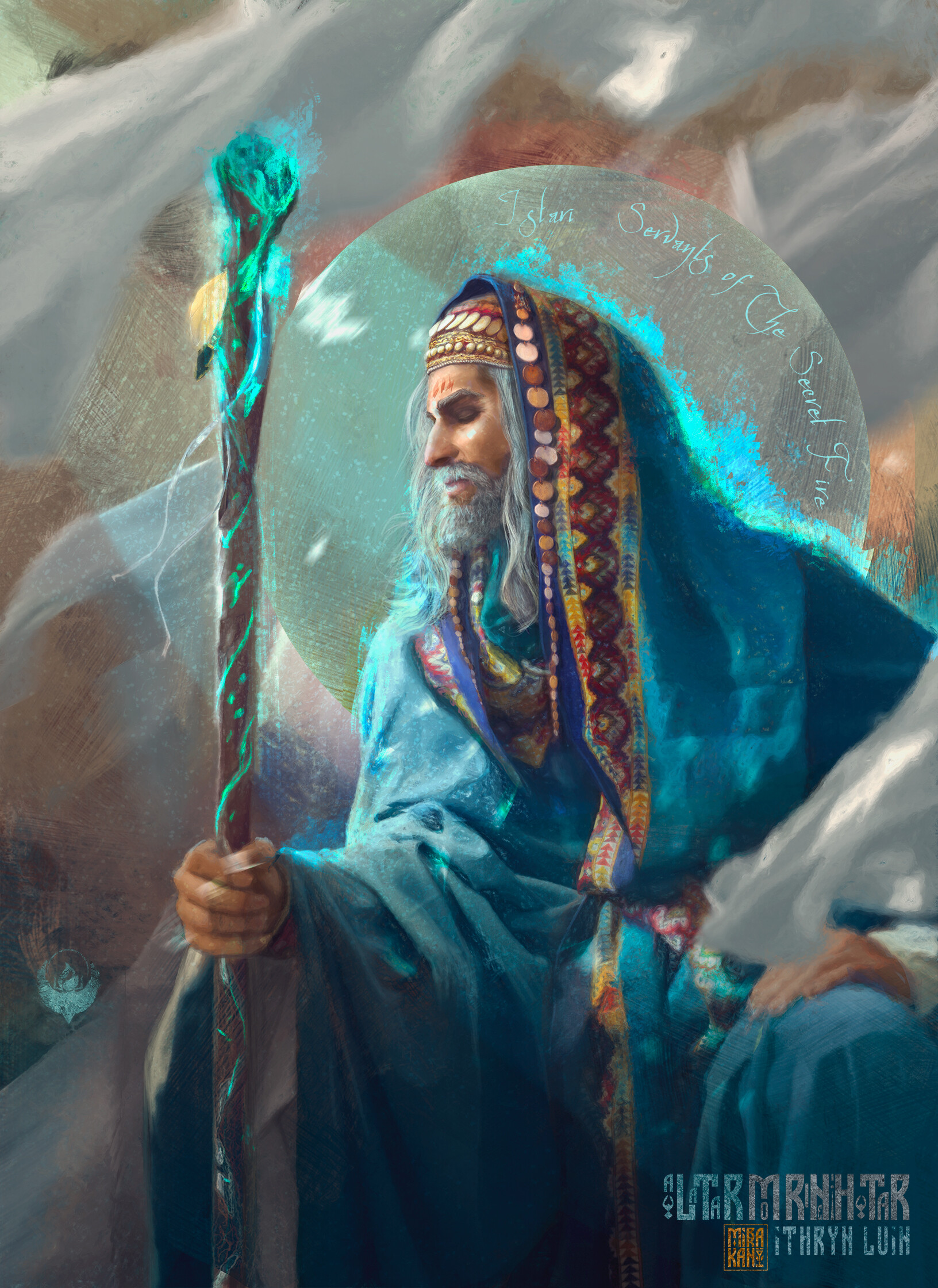
My first encounter with Mirra Kan’s art was when I saw her rendition of the Ithryn Luin; I have always been particularly drawn to the Blue Wizards and I found hers to be refreshingly different from any I’d previously seen, fitting right in with how I imagined them while at the same time adding so much more to my headcanon. And then, to my utter delight, more and more of her art, representing the tantalising southeastern regions of Middle-earth, began appearing in my Tumblr feed.
Mirra describes herself as an orientalist, and in the Tolkien fandom she has a particular focus on the Faithful Haradrim, offering us relatively rare insights from their point of view. People from the South and East in of Middle-earth are mostly generalised as a homogenous corrupt and evil people. Yet Mirra’s illustrations expand on those instances where Tolkien offers us glimpses of their humanity, such as Faramir’s line, “The enemy? His sense of duty was no less than yours, I deem. You wonder what his name is, where he comes from, and if he really was evil at heart.”.
Mirra's work is as visually pleasing as it is thought-provoking, and I've long been interested to learn a little more about her philosophy and the methods lying behind her intriguing artworks that, so it's been a particular delight chatting and getting to know her.
As usual, we eased into the interview with a few background questions.(English is not Mira's first language, and she requesed some light editing for clarity, alhough I've retained her "accent" as much as possible.)
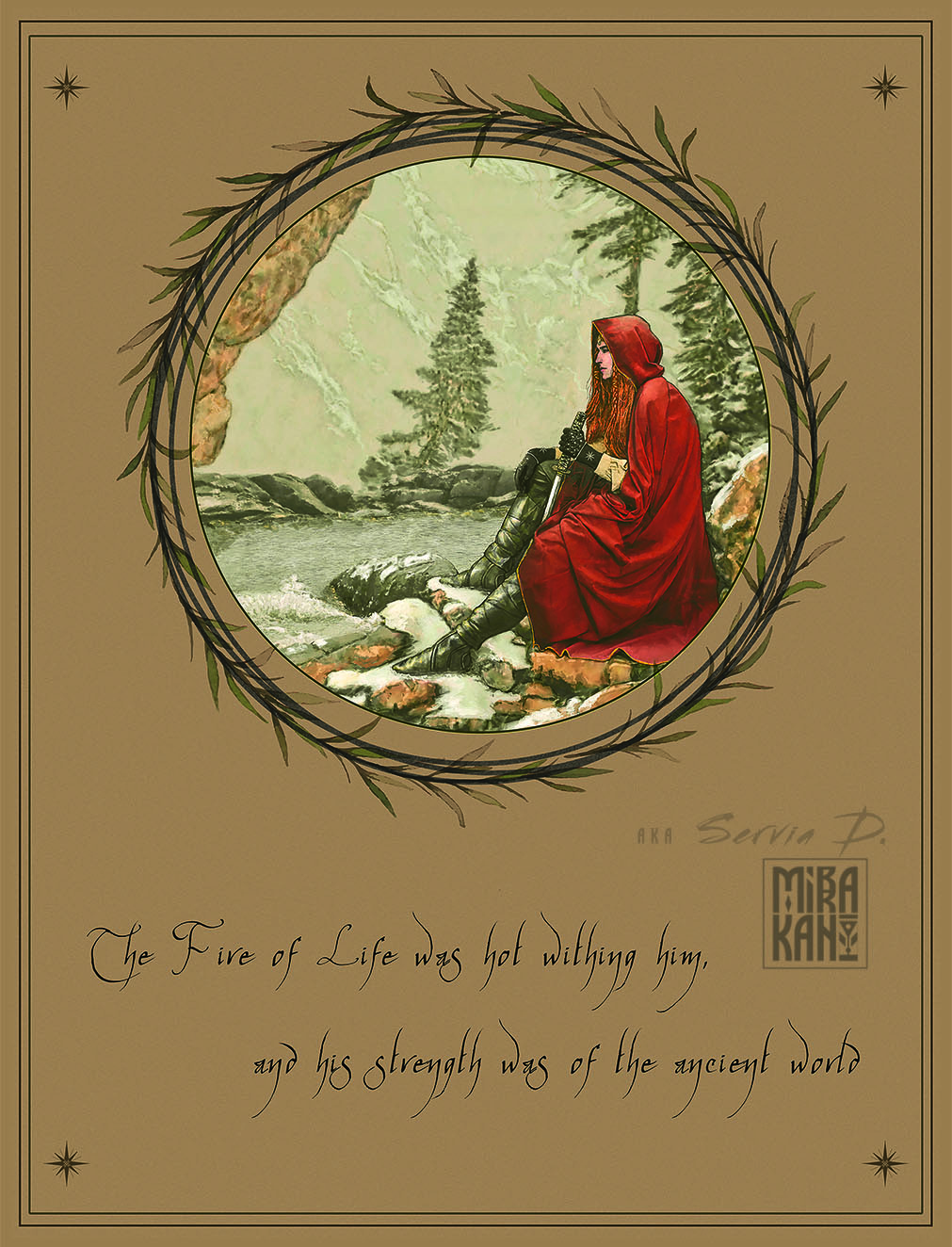
How long have you been creating fanart?
First of all, let me thank you for this awesome opportunity to speak to you and the respected public. What can be a greater joy for an artist than the realisation that your art is actually needed and interesting for other people?
I’ve been creating fanart since 2011 and it was The Witcher fandom at that time. I started with 3D posing but then proceeded to learn actual art to create more meaningful and diverse compositions. So it’s like over twelve years overall, and about ten years of digital painting.
In some ways your art is reminiscent of the classics; do you have any formal training, or did you just pick it up?
No, no formal training, I’m a self-taught artist. But I watch some online lectures and am extremely grateful to all the great pro artists who helped me along the way with their advice and critique—that helps a lot!
I just want to say that I started to study arts when I was close to my thirties. I talk to some people who think that if you’re over fifteen or twenty then it’s no use to even start! So I want to encourage people too. There shouldn’t be any ageism in the arts, I believe.
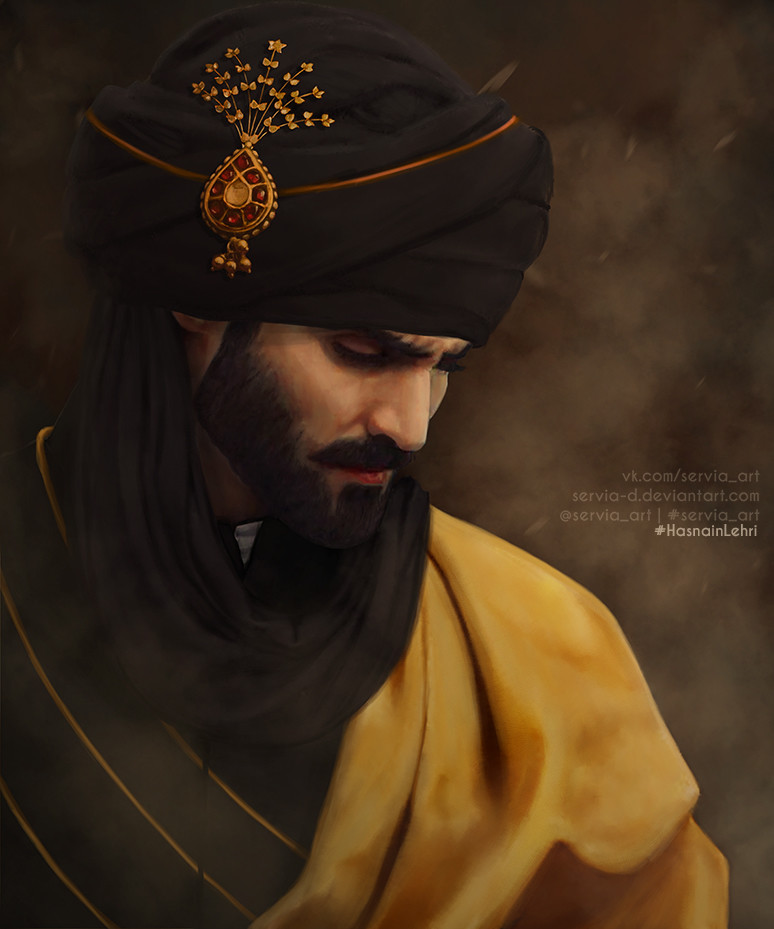
What inspired you to start making Tolkien fanart?
My dearest friend and best person on Planet Earth dragged me into the Silmarillion fandom, for I wasn’t that interested in The Lord of the Rings. (Sorry. Don’t hate me, haha.) So my very first artwork was dedicated to her birthday and it was Maedhros near the river.
One aspect that is really important to me is the Faithful Haradrim and rebellions against Sauron in those regions. Not only the part of people being deluded but also that there was an opposition there. And that Tolkien himself wrote that, if not for the Blue Wizards, united forces of East and South would’ve outnumbered the West. That’s what people tend to miss constantly. And many adaptations (especially the movies) only add a bitter taste of supporting the image of bad fallen guys instead of telling the “real story”.
Do you create art outside of fandom, either as a hobby or professionally?
Yeah, sure thing. I adore oriental styles, and sometimes I just paint things that come in my dreams or while daydreaming. I have also painted some private projects for writers and other customers.
How do you develop your art skills?
YouTube is a treasure! I follow many awesome artists and art schools and try to learn from the best. I also try to copy some classic paintings to understand things like hues and values, although those are just exercises so I never save them. I also try to enrich my “inner reference library”, developing the number of things I know how to paint.
Any new skills that you would like to learn?
Oh, so many! 3D sculpting, for example. Or spine animation so I can bring my static art to life. And of course I still have so much to learn! There’s no end to this road of self-growth.
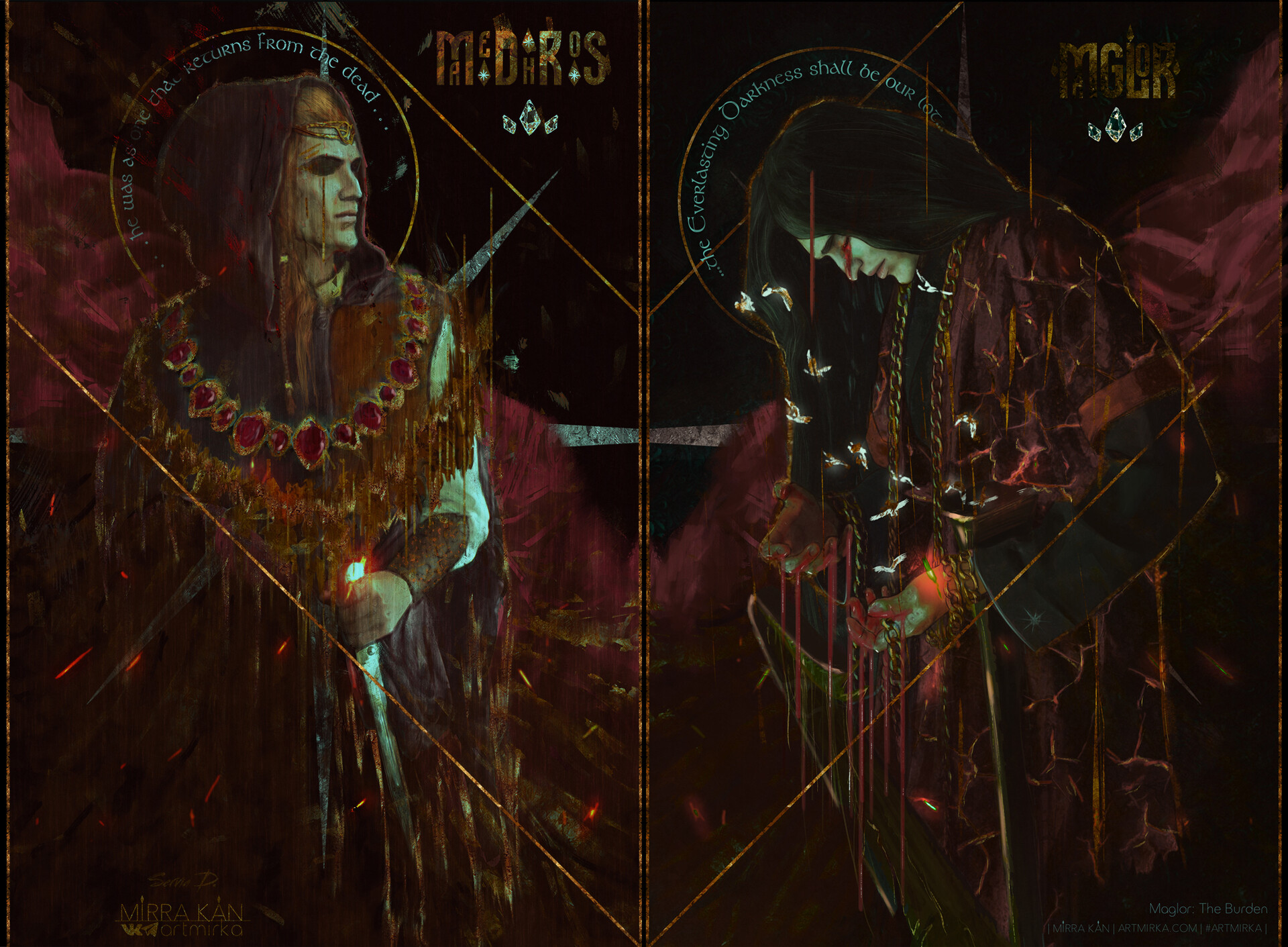
Would you share with us a bit about your preparatory process, such as whether you plan each piece before you start, what research you do, whether or not you use photos or other art for reference?
What a wonderful question! Thank you. I certainly do some planning, and references are a must! How in the world can you paint mediaeval clothing without seeing it? I also try to take pictures while attending mediaeval fests or knight tournaments. Pinterest is also a great source of inspiration. And if I need something specific, I might take a reference shot myself, for example, to understand the lighting.
I also have a lot of oriental trinkets at my disposal so I sometimes use them as a reference: Pakistani pendants, Indian brooches; my favourite ring is a vintage Afghani one that I wear almost all the time. It reminds me of people I need to think about, the history I have to remember, and many other things. It inspires me to tell more stories about the injustices and just … people, who might be trapped by politics, corporations, circumstances, and such things.
How long do you tend to spend on a piece? Do you like to create something within a few hours or a day, or do you like to work on things over an extended period of time. (Or a mix of both, depending?)
It depends; some take days, some months. And then there are the pieces I don’t manage to finish for years. I don’t force it if it’s not about the job contract or something with a deadline. It won’t be any good if it’s forced. It has to resonate with you and then there’s a chance it will come out nice and filled with emotion or a story.
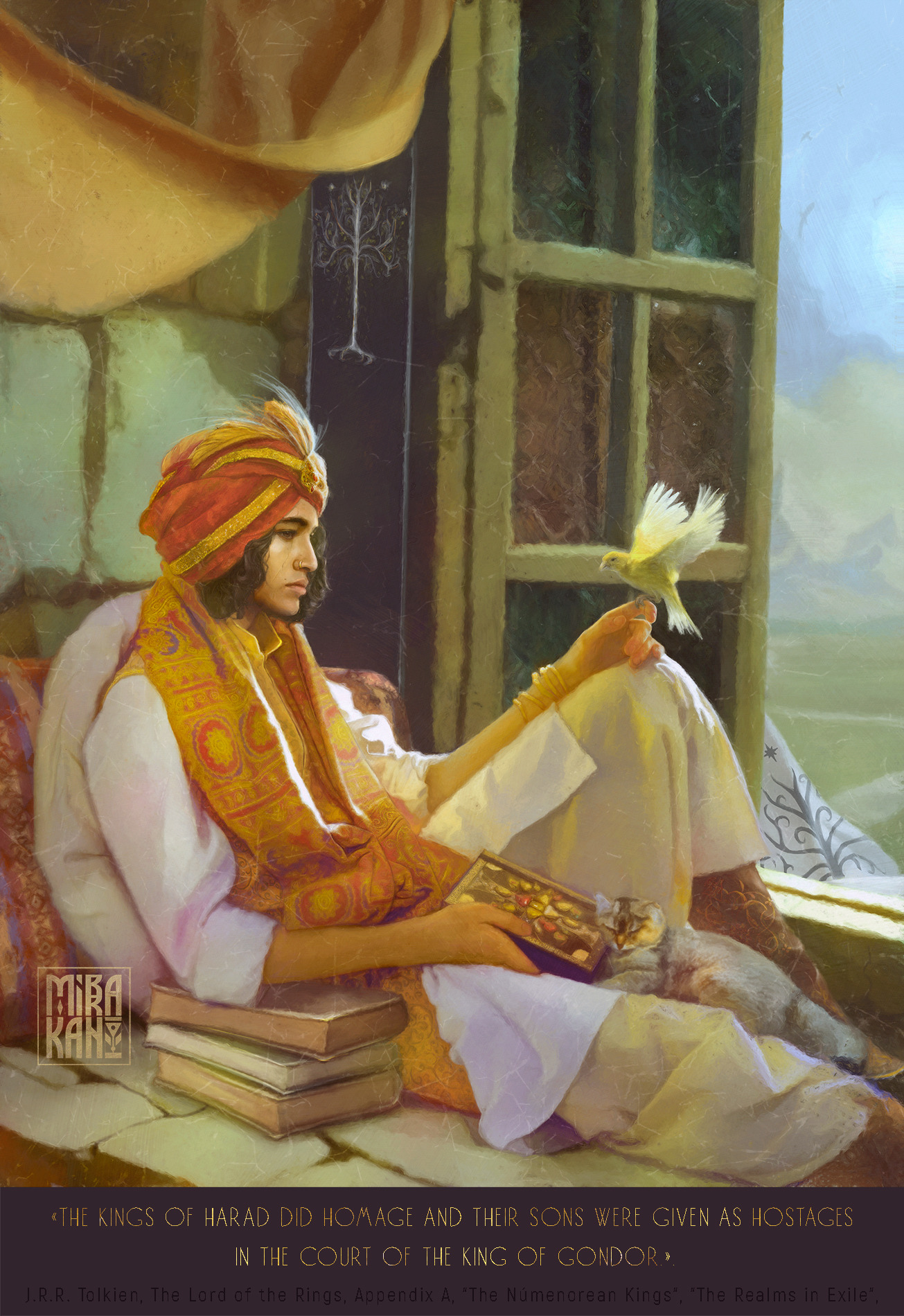
Do you have a favourite time of day to create, and if so, why?
My favourite time of the day is when I have some spare time, haha! Sadly I’m not a full-time artist so I paint whenever I have time. And usually it’s night.
Does fanfiction influence your art in any way?
I don’t read fanfiction much. And absolutely not because I don't like it!! I’m just trying to get the canon settled in my mind first and that’s not the easiest task to do when it comes to Tolkien’s work. And some fanfics are so good they become a semi-canon so I fear to mix things up.
What drives your creative process? Why do you make your art, and how does it make you feel?
Probably the hardest question of all. It makes me think of so many things …
I’d say—people. Their stories. Their development and struggles. And my main motivation is to tell those stories which are “unpraised”. That has always been my main creative motivation: I’m trying to make the audience feel or even just notice something they might’ve missed. Or at least make them consider how the other side of the story may be relevant too.
How does it make me feel? Sometimes sad. Sometimes happy because I managed to capture something I intended to capture. But I’d say the core thing is that my art always motivates me to go forward, to learn more and to become better.
How does your work reflect your values and beliefs?
I never paint something I don’t feel like painting. There were some commissions I didn’t feel like creating for myself, but it never crossed my own lines and beliefs.
I can say, looking at my art on a deeper level, you can understand a lot about me and my values, haha.
What do you hope to inspire in viewers, and what do you hope they come away with from your work?
I don’t want to sound arrogant but … thinking. And compassion. And the willingness to accept, to learn something about characters, circumstances, pretexts, etc.
Anérea: I don’t think this is arrogant at all! One of the core functions of art is to help people to see and think about different things, or to think differently about familiar things. Which is exactly what I see you doing, and I think this is a valuable aspect of your art in terms of opening people's minds about "unpopular" characters as well as real-life representation.
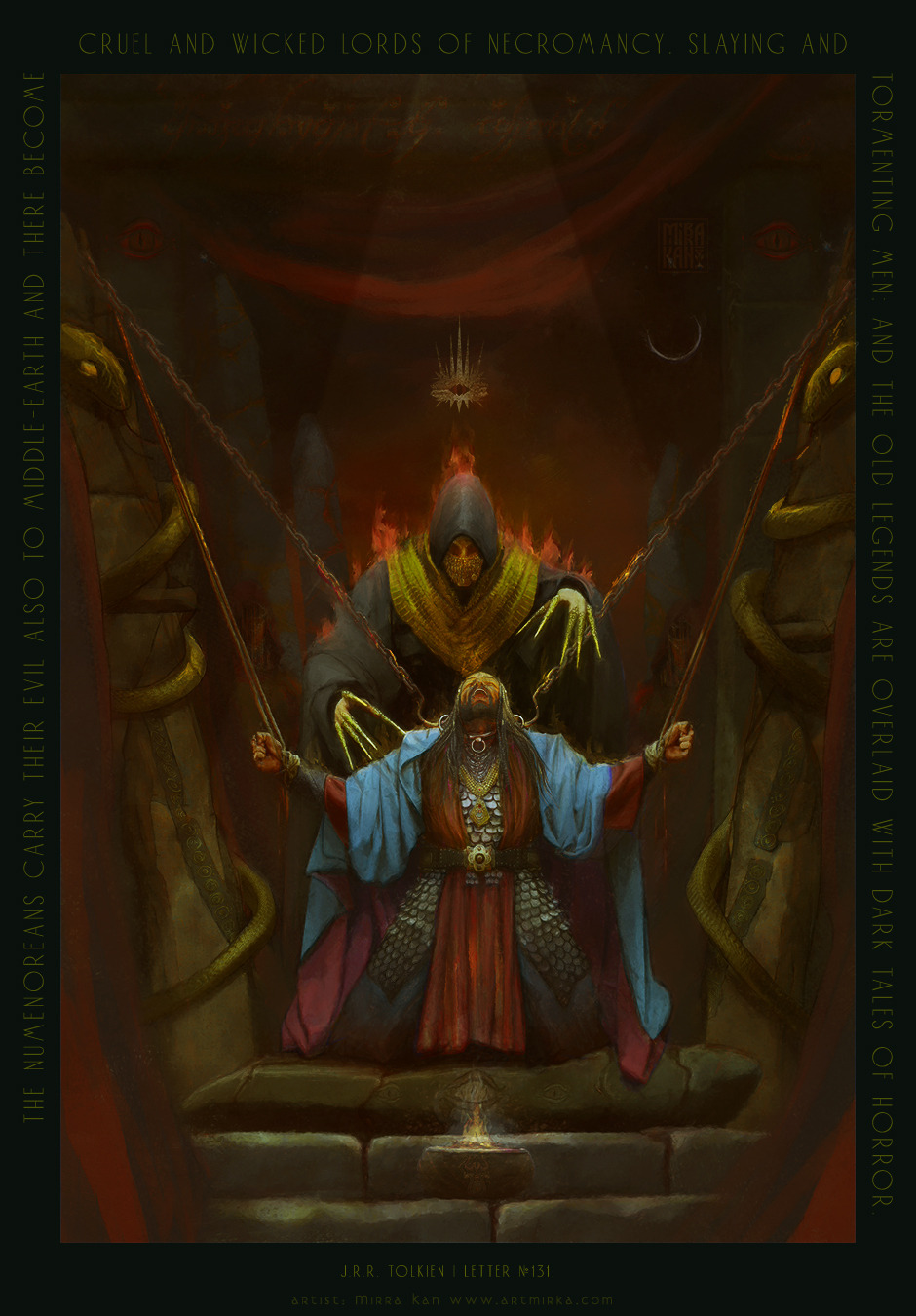
How does receiving or not receiving feedback impact you?
Greatly! I mean, it’s the world to me! But it doesn’t affect me in a negative way if there’s none. Like with my painting about Black Númenóreans: people definitely didn’t get it and it received the worst engagement even though I spent almost a month on it. Yet still, that’s a part of the story we need to look at too, because it presents a totally different perspective of the conflict we witness in The Lord of the Rings. So it makes me sad in a way, but won’t make me stop.
However, when I do receive positive feedback or—especially—when people say that my art made them dig deeper into the story and realise some things, that makes me feel better than anything else. And encourages me to create more and to tell more. Because that’s my main goal: to tell a story of unpraised heroes or at least show the other side of the coin.
And how do you feel about constructive criticism?
I do like to receive constructive criticism, but then what is constructive? Coming from a professional artist, talking about my strong and weak points and how to fix that—precious as life itself. Just a “critique” about liking or not liking the particular character … that’s a totally different thing.
One of the main critiques I receive from the audience is that I don’t paint women that often and I truly consider it to be a problem. Will I just start to paint them because the audience demands? No way. It won’t be any good, in my opinion. So people won’t enjoy it anyway.
Are there any particular artists who've influenced your work—inside or outside of Tolkien fandom?
Sure thing. The classics, to start with: Jean Leon Jerome, Repin, Vereschagin, Rembrandt van Rijn. And switching to our contemporary artists: Noah Bradley, Stepan Alekseev, Peter Mohrbacher, David Kassan, and so many others. I look up to those artists.
Tolkien fanart is great! Artists like Mandhos, Anato Finnstark, Silmaspens, Rina Korotkova (firinaira), Maria Filatova (rittare), Elena Kukanova, Ylieke, Yidany, and Ira Allor really make my day every now and then!
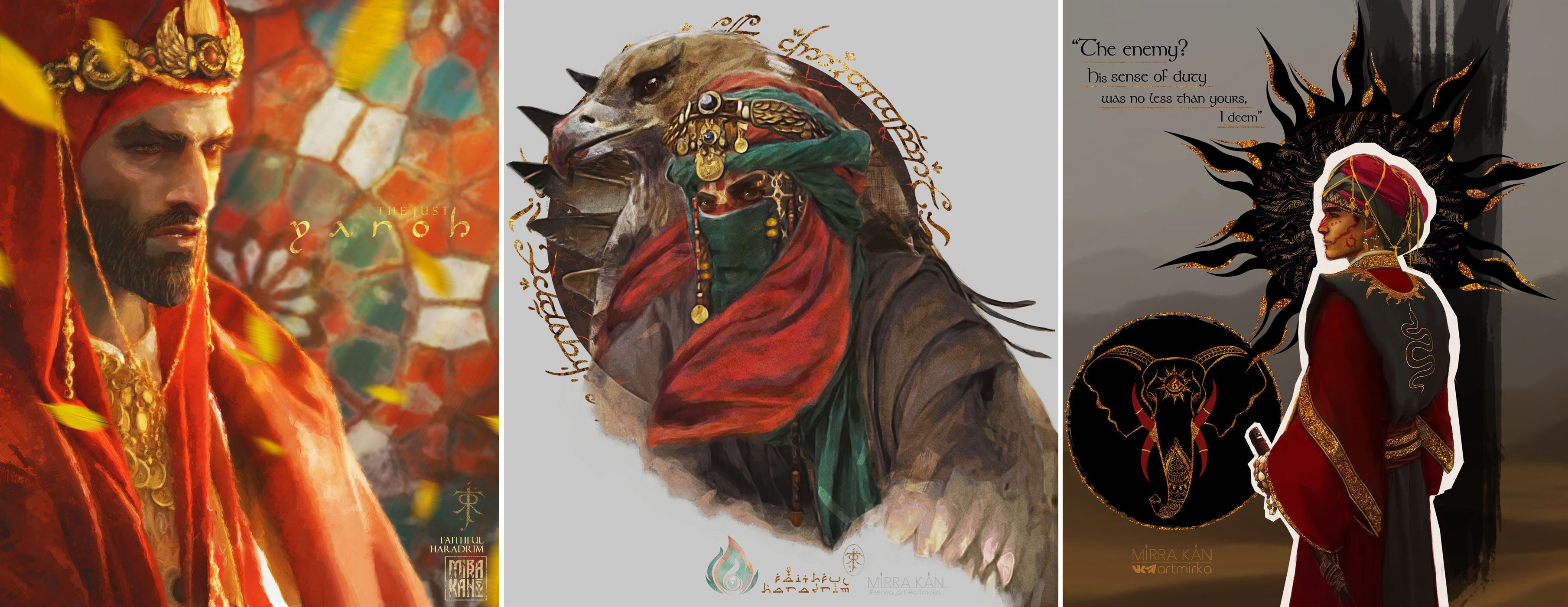
Middle Eastern cultures are also a clear influence in your art, and your Tolkien fanart is very emotive and carries clear messages. What prompted your passion for Oriental cultures, and to represent them through the Tolkien fandom?
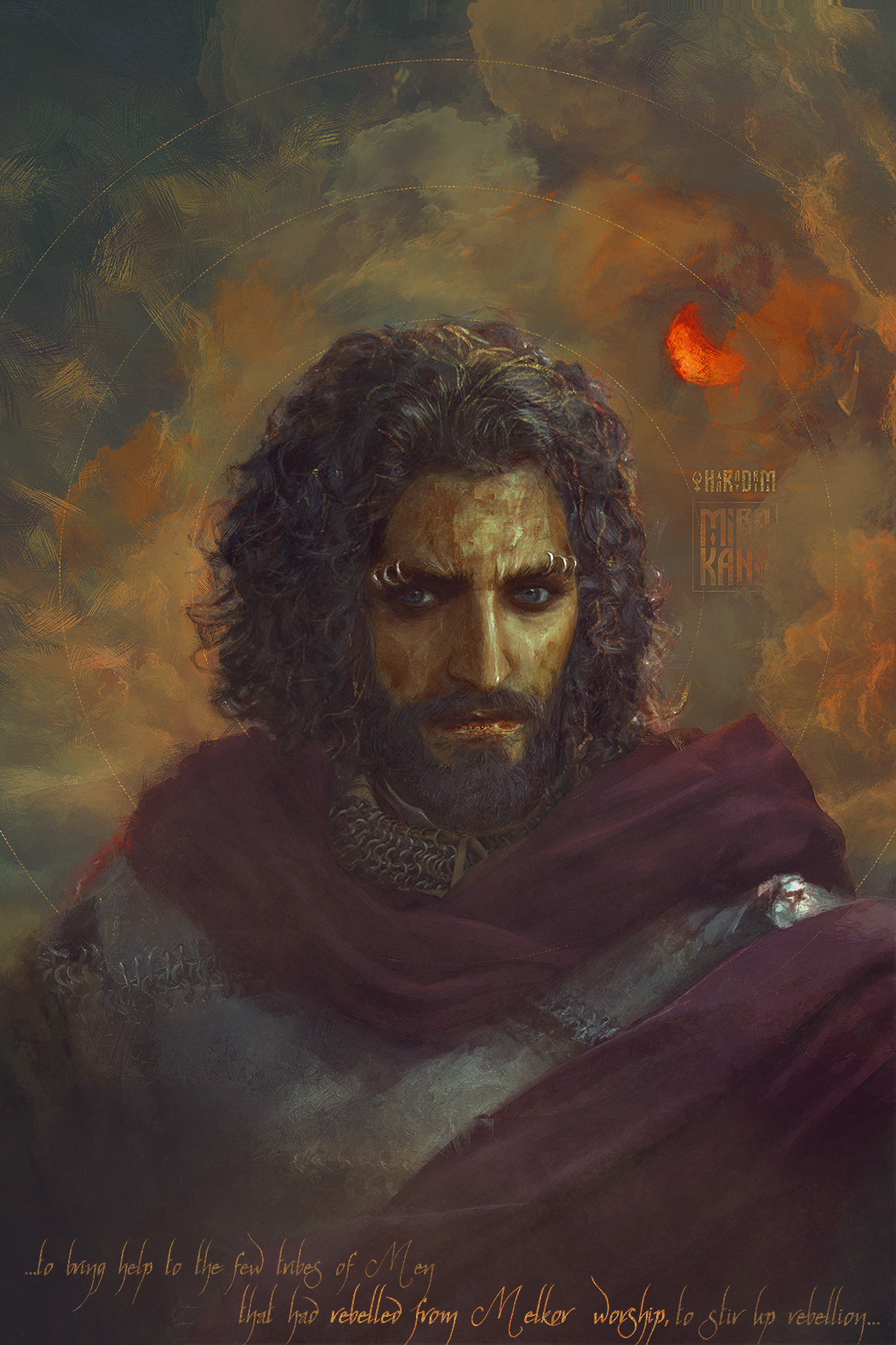
Oriental art (and classic art in general) has always been a part of my daily life. My grandmother used to take me to museums and tell stories about paintings. She was the one who made me meet my creative self. Later on I started to study what we call Eastern philosophy and literature at University: Rumi, Ferdowsi, Hafiz, Khayyam, Lao-Zi, Confucius, and many others shaped my very first impression of the cultural aspects of the regions.
Studying International relations has taught me a lot too, and my extra psychology degree added a pinch to it too. I spent several years studying the art of Chinese Tea Ceremony (GunFu Cha) and then … I faced the world. The real world of hypocrisy and misinterpreting the history and traditions.
Becoming more aware of some media technologies, I watched how the post-truth paradigm had been created; how lies and misunderstanding led both sides to conflicts based on mutual distrust. So when I explored Tolkien’s world I was stunned by the amount of ways that deeper motives form the Legendarium of Middle-earth. I was amazed by the true pretexts and the logical thread of events. Tolkien is more than just stunning and I also felt a bit misled by the movies and the “media-image” of what we call Tolkienistics. Because on the surface those are mostly about some guys being great and others being bad … just because. No, Tolkien is so much more than that and I felt that creative fire burning inside—the urge to tell, to share, and to spotlight some things people tend to ignore: colonial past, slavery, dark cults, necromancy, and people staying faithful with no Elves to guide them, no extra buff. Just imagine Haradrim trying to oppose Númenóreans! That’s so relatable to so many stories in real life, isn’t it? And I feel so sorry for those people and for the fact that their deeds and sacrifices are almost utterly disregarded, and that there were heroes fighting and dying for the sake of a better future for their children.
I’m so dramatic, aren’t I?
Anerea: This is very valid, and pertinent. I think this is exactly why a lot of people enjoy delving deeper into Tolkien. And also exactly why I, and many others, are drawn to your art—there's a depth to it, you get people to ask questions—difficult questions, and to look deeper.
What are some of the challenges you face as an artist? And what ways have you found helpful in overcoming them?
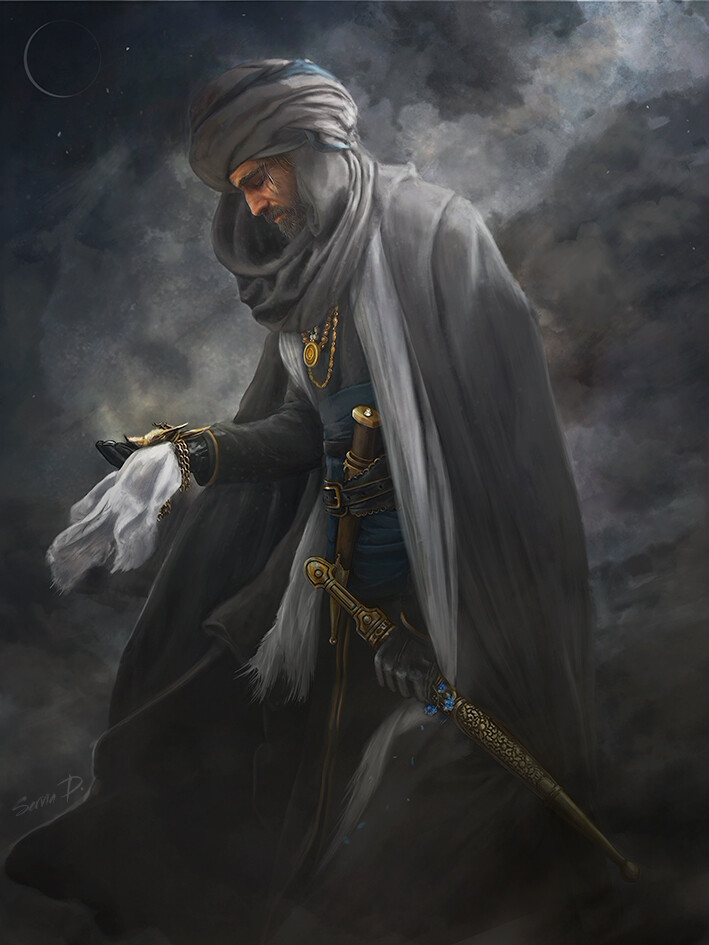
I won’t say something outstanding here—imposter syndrome is my 24/7 struggle. Being bullied and humiliated as an artist made me really sensitive art-wise. That meanness is now long gone, but not from my mind.
What do I do? Talk to the many wonderful people around here! And saving screenshots of their feedback to look through when I feel like quitting. Also my best friend helps me a lot. If not for her, I believe I wouldn’t be here, painting, now.
I’d like to add that I started to paint digitally due to severe allergies. And people just judge you without knowing the context, and are so focused on the form not the message; I'm not sure if other digital artists (especially aspiring ones) face such kind of discrimination or disrespect towards their art.
Anerea: I relate to this; when I switched from film photography to digital I got a lot of disparaging comments, to the effect that any creative input after clicking the shutter was "cheating", whereas traditional photography has always been very much about post-processing skills in the darkroom.
Because the majority don’t understand that even to work with digital you've got to learn it! Invest and develop your skills. But yeah, if traditional artists use stamps and ink cliches, it’s okay, it’s great. If digital artist uses custom shapes—that’s cheating and soulless—omg! -_- Same applies to every digital media. And now this AI has emerged.
Anerea: I've come across that discrimination, towards other artists' work as well as my own. And it took me years to realise how deeply my belief in my self had been impacted by all those negative judgements (that mostly stem from ignorance) because when I first started making digital fanart I automatically felt it was inferior, and found it hard to shake that internalised belief, even though my art was welcomed with only positive feedback..
We have to fight our inner demons all the time, indeed. You know, it made me think about the web being so great again! Because I have never faced bullying on Tumblr or Instagram— I found my encouragement there. And so many lovely friends and tutors!
Anerea: I've also had the experience of this online community being so accepting and understanding, and I'm so pleased you have too. I've encountered others who have experienced a prejudice against digital art, and it is a comfort to find community with others who relate, who understand and can spread awareness and acceptance of the mediium.
Do you have any particular artistic goals?
Hard to tell. We all want recognition, I believe, so I won’t go with “just to bring joy to people” hypocrisy, haha! If we’re talking about the artistic goals—recognition, for sure. And probably the Tolkien Society's Best Artwork award! I haven’t seen any Harad art ever getting one.
If we’re talking about the moral aspect of it (here we go again): to tell the stories of unpopular characters and make people “meet” them.
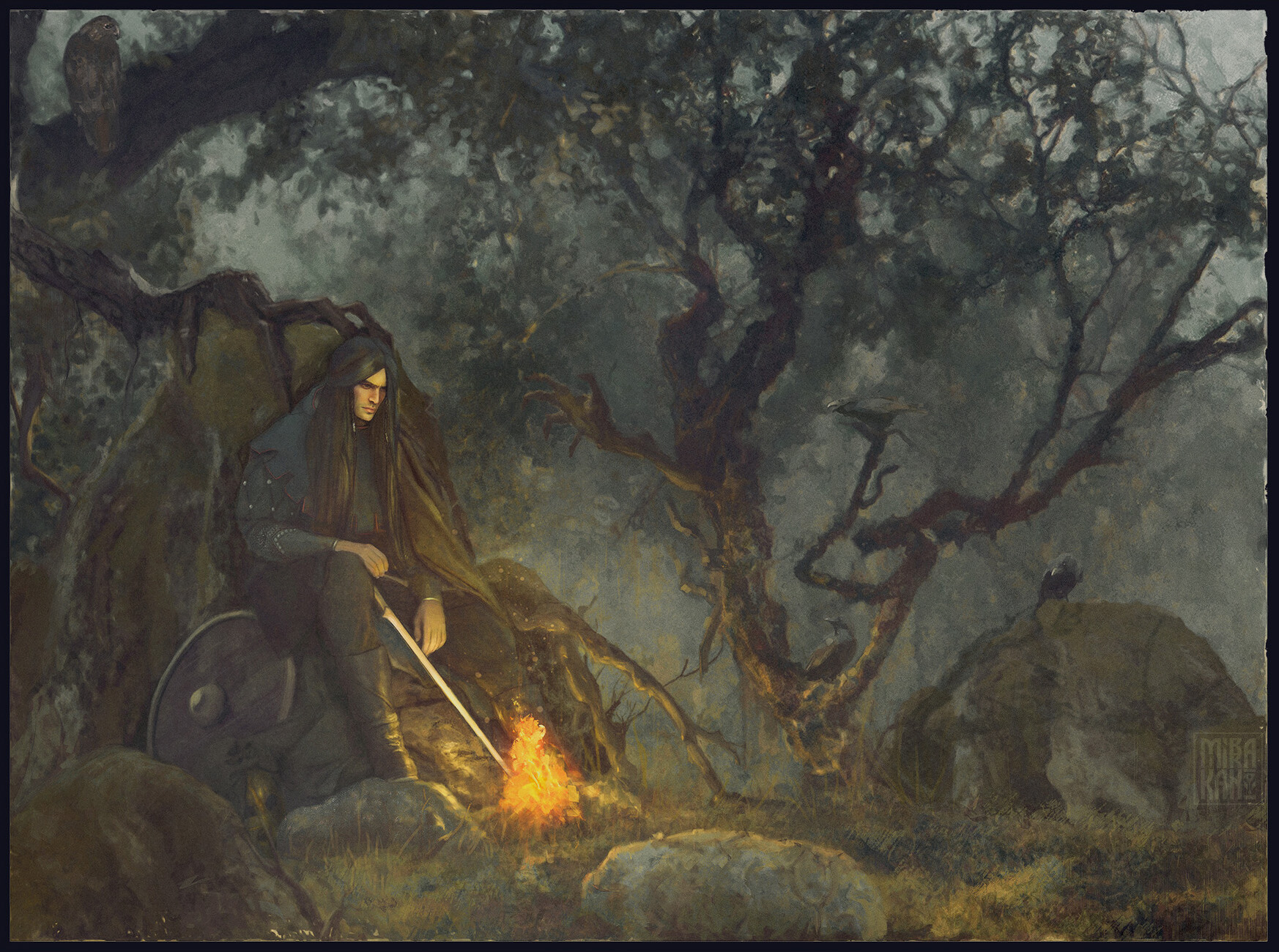
What do you appreciate as being your biggest strength?
Willingness to learn. To accept. To share. <3
I've met so many wonderful people along the way. Pro’s who shared their expertise with me, common people who assisted me on a daily basis, especially when I was down. So I take it as my responsibility—and duty—to help and share.
And what aspects would you like to improve?
I have too much sensitivity, which doesn’t work well in the artistic niche. Especially on the web. Sadly.
What is the best advice you’ve received as an artist?
Watch this world closely. Get as many experiences as you can. Watch the light flow, visit mediaeval fests, exhibitions, and take references wherever you go. That’s the key to making better art. Not even a technique. If you have the technique but don’t know what a real-life experience looks like, you won’t be able to capture it. Study people. Study nature. Study life.
Any advice of your own to pass on to aspiring artists?
Don’t give up. Simple as that. There will come a day, if you don’t give up, when you’ll get better as an artist. Technique takes time—there’s no limit to perfection, as they say. I talked to super-pro artists and almost all of them weren’t completely happy with their works. They continue to study on a daily basis and—trust me—the artist you look up to, looks up to someone too.
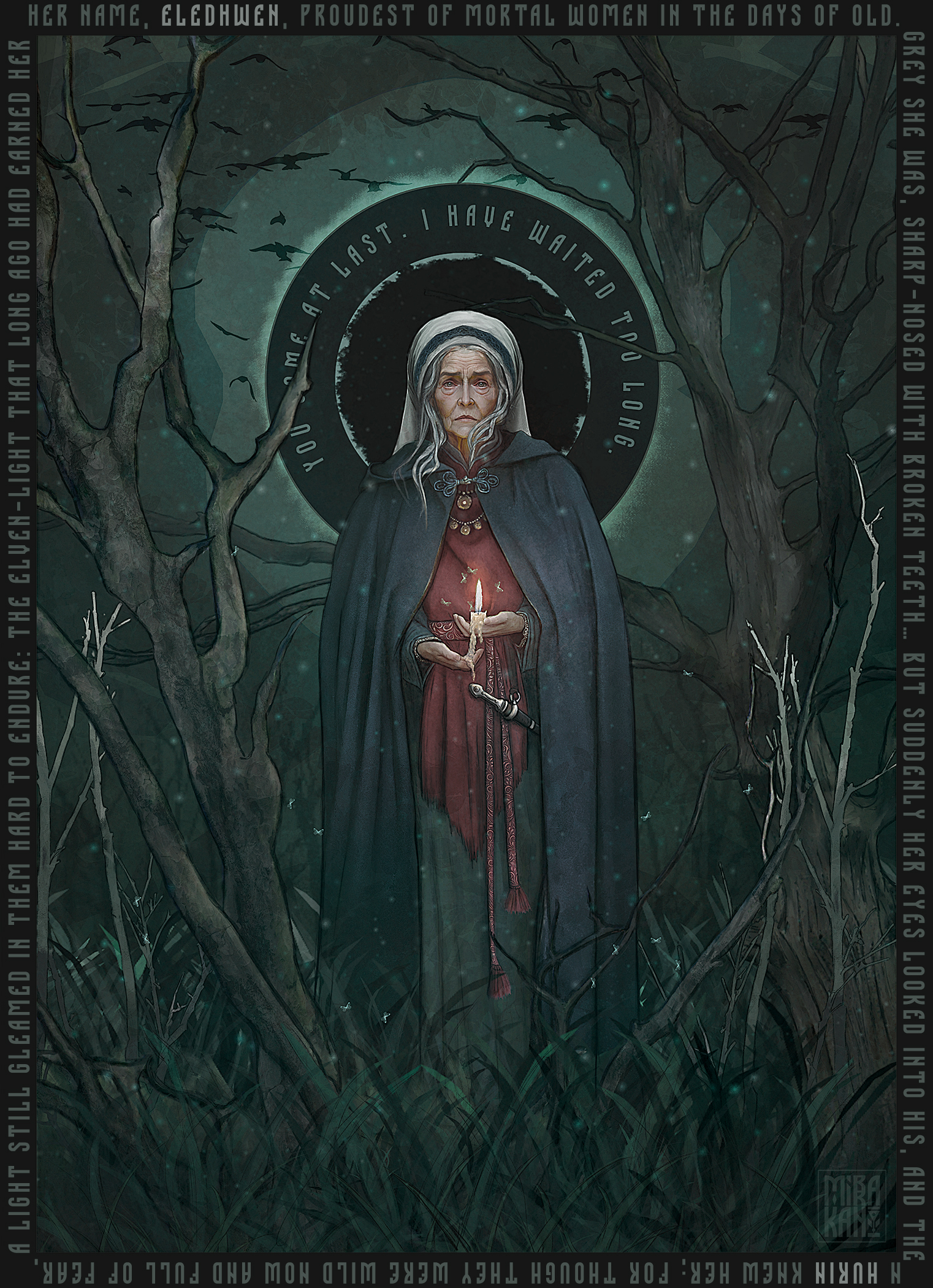
As a fanartist, what is the most rewarding thing for you?
Connecting to so many wonderful people around the world! Finding someone you can share your thoughts and interests with. And just enjoying their creative process too. That’s a real treasure.
What has been your favourite piece or project to work on, and what made it stand out for you?
What a master of tough questions you are! -__- I’d say there are three: Mourning; Túrin Turambar, The Cursed; and Morwen. Can’t say it’s been a pleasure, huh. But I was really excited about bringing those images to life.
I put a lot of myself into it, and that’s all I can share.
Do you have any upcoming projects that we can look forward to?
Sooo many! Thanks for asking: 2024 will bring more Children of Húrin and the Blue Wizards/Haradrim art. I focus on Near Harad for now but am going to gradually make more art about Far Harad, Rhûn\Khand, Númenórean expansion, and all the things related to the complicated history of Middle-earth.
What do you enjoy doing when you're not making art?
Reading, mountain hiking, and spending time with my family and friends. We usually combine those things in one to be honest, haha.
Do you enjoy listening to music while you’re working, if so, what music?
That’s a must! :)
I usually pick the most authentic music to keep the vibe. So I made playlists like “Harad”, “Túrin”, “Morwen”, “Faithful Haradrim”, etc. Those are mostly ethnic and throat singing. I adore it.
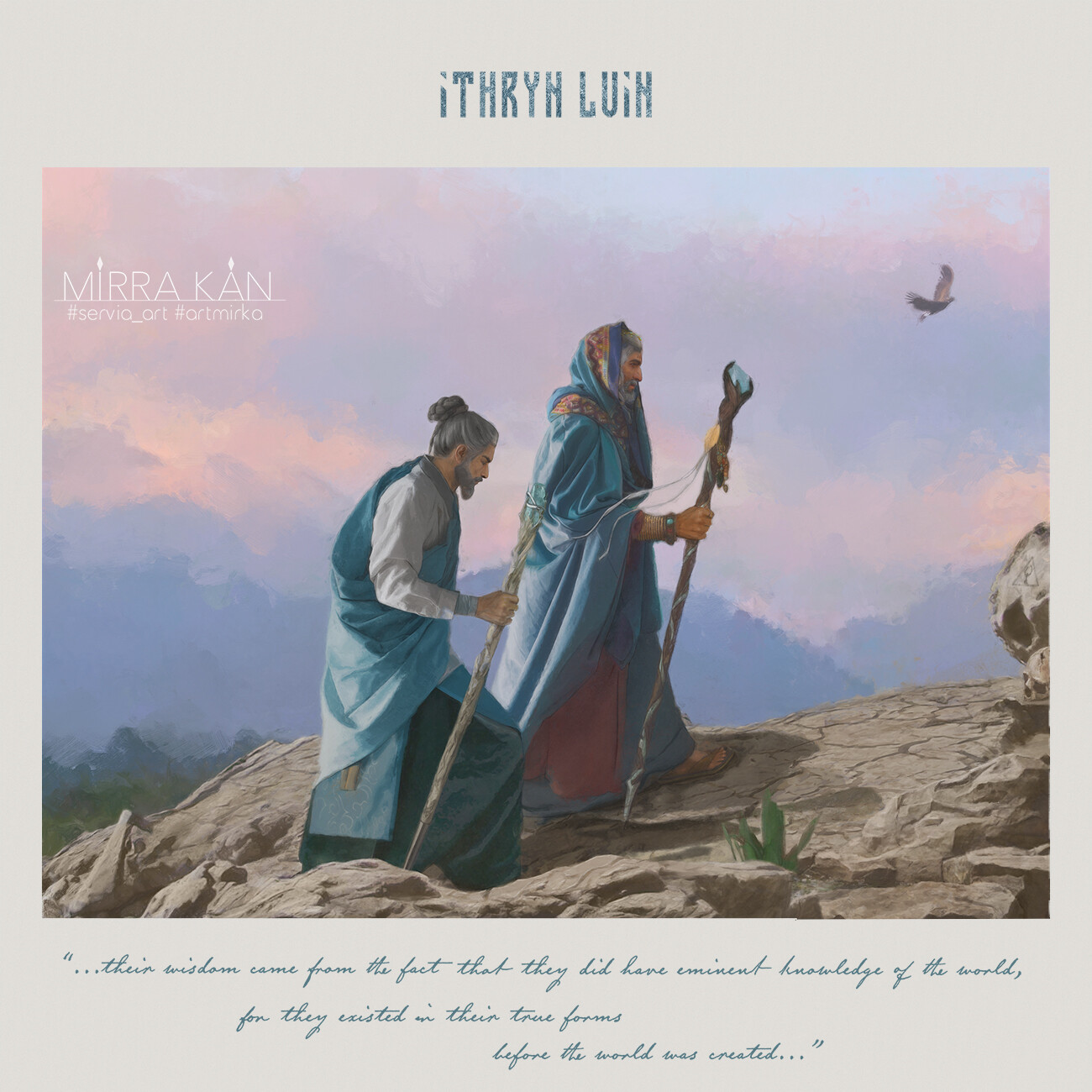
And just for fun: if you could spend a day with any Tolkien character(s) or Tolkien fandom OC(s), who would you choose to be with? Where or when would it be? And what would you do?
The Ithryn Luin. Alatar Morinehtar in particular. When they had to resist Sauron’s influence and encourage people. I really like the change to their story when Tolkien decided that the Blue Wizards should’ve arrived earlier than other Istari and Mayar. Regarding Númenor’s expansion, it’s totally understandable and a great move, to be honest.
I’d ask him so many questions. About the tough choices and people. And I think I’d mostly watch and learn their wisdom. And strength. And if I could, I would’ve tried to help as many people as I can.
Anything else you’d like people to know about you and your work?
I just want to tell you that every piece I create is filled with my soul. Even if those aren’t perfect in some aspects, I put everything I have at my disposal at that moment ino it.
And also—I’m extremely grateful for people's support! I read all the tags and try to thank people by messaging them but sometimes Tumblr won’t let me. So—keep in mind—I see it and that makes me feel alive! Thank you!
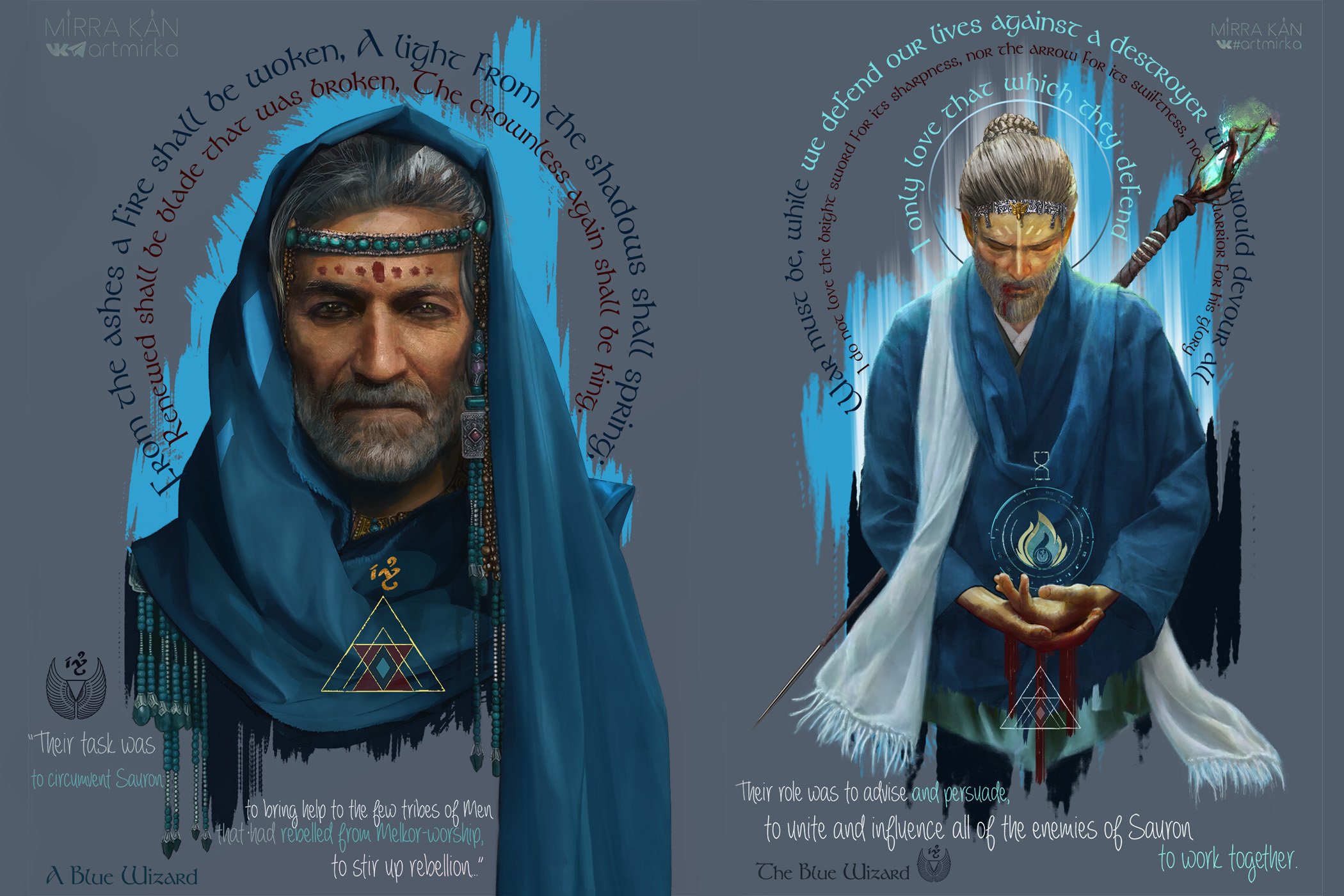
I derive so much enjoyment from Mirra's art; it never fails to make me pause and zoom in each time it appears in one of my feeds, like refreshing mini breaks in my day. All the art featured above can be viewed large by right clicking each image. As usual, it's been tough making a small selection to feature, but you can see more of Mirra's art and read some of her thoughts and headcanons on her website, Tumblr, and VK.


Love Mirra Kan's art
I really enjoyed reading Anerea's interview with Mirra Kan. Anerea asks such good questions, and Mirra Kan's art is so beautiful. I was astonished to find out that she's a self-taught artist and that she started when she was older. I never would have guessed that. I love her passion for her subject matter and her unique perspective.
♡
Thank you so much for your comment, and so pleased you've enjoyed the interview and art!
Beautiful and evocative art
I hadn't run across Mirra Kan's artwork before. Her subjects are really interesting, and the colours, backgrounds and unusual character choices are fantastic. The path to becoming an artist (and her advice) feel ever so helpful as well. A lovely interview.
♡
Oh, it's such a lovely feeling introducing people to art I love! I'm delighted that you appreciate both her art and what she has to say! Thanks for sharing!
Absolutely fabulous artwork…
Absolutely fabulous artwork and very interesting interview, with perceptive questions and great answers.
I'm amazed at the lack of feedback for the Black Numenoreans artwork. It's stunning, powerful and very thought provoking.
♡
Thank you so much for your lovely comment! It's really the artist's responses that make the interview interesting, and I'm really glad my questions have aided that!
And I completely agree with you about the "Black Númenóreans" painting.
It was so thrilling to…
It was so thrilling to encounter Mirra Kan's take on the Haradrim and the Blue Wizards!
I was very glad to learn more about her and her work in this interview!
♡
Thanks Himring! I'm so happy you enjoyed her work and thoughts behind it! :)
Her art is sublime. I was…
Her art is sublime. I was particularly excited when I first saw her Haradrim OC on my tumblr dash. There's an undeniable bias here because it's close to how I portray Harad (in my head) :þ I like how she answers: short, concise, and to the point.
♡
I'm so glad you enjoyed Mirra's art and the story behind it! Thanks for letting us know. ;)
Great interview! I love…
Great interview! I love Mirra's art and this interview really deepened my appreciation for it.